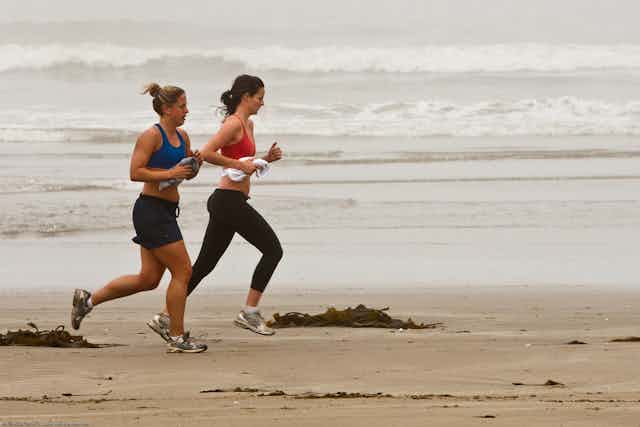If you’re female and exercise, a certain amount of breast movement is inevitable. But bosom movement extends beyond bouncing up and down – it also involves moving side to side, which impacts on breast health.
Since 2005, a team of researchers at the University of Portsmouth has been investigating the way women’s breasts move during exercise. Headed by Dr Joanna Scurr, the Research Group in Breast Health has been examining the topic from a biomechanical, physiological and clinical perspective.
With the female breast moving up to a recorded 21cm during excise, it’s no surprise that 72% of exercising females experience breast pain during physical activity. Unfortunately, the anatomy of the female breast includes only weak, natural supporting structures known as the Coopers ligaments, which weave between the milk glands in thin, fibrous sheets.
These structures have been shown to extend more than 2cm during a short bout of running. Theoretically it is possible that continual tugging of the Coopers ligaments, such as the movement of breasts bouncing up and down without support, may undergo “creep”, which means lengthening.
That’s where the idea of breasts “sagging” comes from. But of course, it must be understood that the primary support of breasts is the skin covering them. As you age, that skin thins and its elasticity decreases.
These negative consequences of breast movement deter women from participating in physical activity and an external support garment is required to ensure exercise can be carried out without breast bounce – the sports bra!

The first sports bra, dubbed the “jockbra” was developed when a woman sewed together two jockstraps in 1977.
Christine Haycock, an associate professor of surgery at the University of Medicine and Dentistry of New Jersey and pioneer of the sports bra, ran surveys on colleges athletes looking at issues peculiar to female athletes and was surprised that breast discomfort during exercise popped up.
She made the first recommendations of the qualities that need to be in a sports bra and now, new developments in fabric, design and biomechanics have seen the sports bra progress into a highly engineered and effective product that works to reduce breast pain, injury and discomfort during exercise.
It’s strange to think that the sports bra only came to be around in the 70s, considering women participated in the Olympics since the early 1900s in sports such as tennis, sailing, croquet, horse riding and golf. But the advantages of a sport such as tennis is the distance in which you run is not tremendous.
In comparison to marathon running or netball and hockey, women are running and jumping, which means more vertical breast displacement.
Hundreds of women, ranging from an A to a JJ cup size, have been tested in the biomechanics laboratory at the University of Portsmouth. Participating in a variety of everyday and sporting activities, a state-of-the-art camera system tracks breast movement in three dimensions (up and down, forwards and backwards, and side to side) throughout.
The procedure has been applied to determine the effectiveness of varying designs of breast support, with the aim of evaluating the development of better products to support the health of the breast.

Results show that the breast moves independently to the torso in a butterfly formation during running, with 50% of this movement occurring in a vertical direction, 25% in a forwards/backwards direction and 25% in a side to side direction.
Studies have also shown that breast pain occurs not only due to the independent movement of the breast tissue during exercise, but because the breast moves out of synchrony with the body.
Due to the mass of the breast, there is a time delay in its movement compared to the torso, increasing the stretch on the Cooper’s ligaments.
The support of the sports bra aims to help the breasts and the trunk of the body to move as a unit which is more like a man.
A good sports bra can affect more than just the breast itself. Research from the University of Portsmouth has shown that wearing a sports bra reduces the activity of the pectoral muscle by 55%, which may affect a woman’s muscular fatigue during running.
Insufficient breast support can significantly increase the forces exerted through the leg and onto the ground during running, which may lead to an increased risk of injury.
A woman’s choice of breast support can also influence her breathing rate, lung capacity and thermoregulation during exercise.
The consequences of selecting a bra that provides poor support to the breast may affect elite sports women and recreationally active individuals alike, whether exercising for five minutes or during an endurance event, and during a variety of different activities.
When choosing a sports bra, it’s recommended women try on a variety of bras and select the one they feel is most supportive. A professional bra fitting is always recommended, particularly for larger-breasted women.
It is also recommended that women follow five simple steps to obtain the perfect bra fit:
- the band is horizontal all the way around
- the cups do not bulge or gape
- the under-wire follows the natural curve of the breast tissue
- the front of the bra sits flat against the chest wall
- the shoulder straps are adjusted appropriately
By investigating breast pain, the mechanics of breast movement and the influence on sporting performance, we are broadening the understanding of the breast, informing breast support design, and raising awareness of an important quality of life issue for women.

